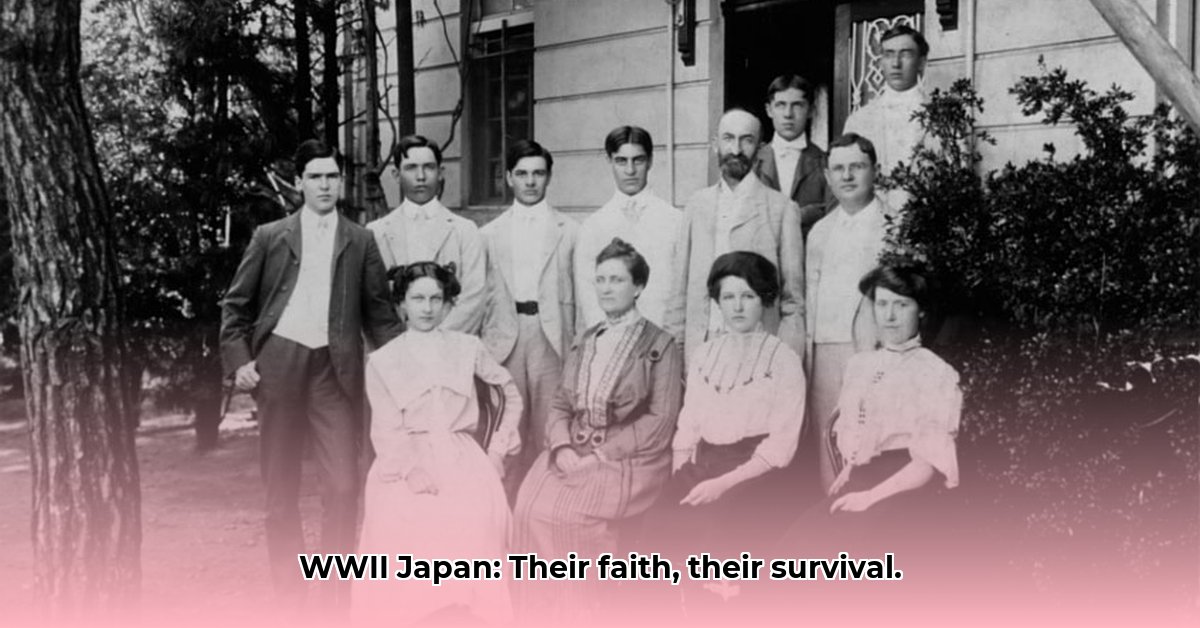Imagine Hiroshima and Nagasaki after the bombs fell—devastation everywhere. But amidst the rubble, something amazing happened: Christian missionaries persevered. This story isn’t just about heroic survival; it’s a fascinating look at how faith, resilience, and cultural barriers collided in post-war Japan. For more on missionary life in this era, see this account of missionary experiences. We’ll uncover surprising tales of churches that miraculously survived the blasts, explore the unexpected early success of missionary efforts, and examine why, despite their best intentions and some initial wins, widespread conversion remained stubbornly elusive. From General MacArthur’s ambitious call for thousands of missionaries to the everyday struggles faced by those on the ground, we’ll paint a picture of this pivotal moment in religious history, learning valuable lessons about the triumphs and challenges of spreading faith across cultures, even in the face of unimaginable tragedy. This isn’t simply a historical account; it’s a story with modern implications for how we approach mission work today.
Missionaries in Japan During WWII: Faith and Perseverance
The year is 1945. Two atomic bombs have ripped through Hiroshima and Nagasaki, leaving landscapes of unimaginable devastation. Yet, amidst the rubble and ash, something unexpected stands: churches. Buildings belonging to Jesuit and Franciscan missionaries somehow survived. These weren’t just buildings; they were beacons of hope, offering solace in a world turned upside down. Was it divine intervention? Pure chance? Or a combination of both? We may never know for sure, but their survival became a powerful symbol in the years to come. What role did faith play in helping people cope with the aftermath of such immense destruction?
These surviving structures provided a critical foundation for the religious landscape of post-war Japan. The immediate aftermath saw a surge in missionary activity. General MacArthur’s bold call for 10,000 missionaries, though not fully met, spurred significant movement. Many missionaries, previously working in China, found themselves redirected to Japan. Early efforts were surprisingly successful; simple street meetings attracted listeners eager for a message of hope and comfort. But the initial enthusiasm would soon face significant challenges. How effective were these initial missionary efforts in establishing a lasting presence?
The road to widespread conversion proved far bumpier than initially anticipated. Why didn’t Christianity take root more profoundly in Japanese society even decades after the war? Several factors likely played a role. The deeply ingrained traditions of Shinto and Buddhism presented formidable obstacles. These weren’t just religions; they were interwoven into the very fabric of Japanese culture, shaping worldview and daily life. Moreover, post-war Japan experienced a remarkable economic boom. This rapid growth led to a more materialistic culture, where the pursuit of financial success often overshadowed spiritual considerations.
The demanding work ethic, a defining feature of Japanese society, also impacted church attendance. Imagine working incredibly long hours, six or seven days a week. Sunday, the traditional day of rest and worship, often found workers exhausted, leaving little energy for religious observance. This wasn’t a rejection of faith, but a practical consequence of the prevailing work culture. What strategies did missionaries employ to address the challenges posed by Japan’s unique cultural and economic landscape?
Historical accounts of missionaries during the war paint a varied picture. Some records detail the internment and hardships faced by missionaries, while others highlight the incredible resilience of smaller, independent faith communities that persevered despite the challenges. These discrepancies aren’t necessarily signs of error, but rather reflections of the diverse experiences within a vast and complex historical event. Reconciling these differing perspectives requires careful consideration of the limitations of available data and the nuances of individual stories. History, after all, is rarely a neat, concise narrative; it’s a tapestry woven from countless individual threads. How do we reconcile conflicting accounts to gain a more complete understanding of the past?
So, what lessons can we glean from the experiences of these missionaries? The initial success suggests the importance of adaptability and cultural sensitivity. The missionaries who succeeded were the ones who made an effort to understand and connect with the Japanese people on their own terms. On the other hand, the limitations highlight the need for long-term commitment and a profound understanding of the local culture. It wasn’t just about sharing a message; it was about building relationships and genuine connections. This post-war experience offers invaluable insight for modern missionary work, emphasizing the necessity of developing highly targeted strategies tailored to each specific cultural context. Considering the changing global landscape, how can missionary organizations adapt their strategies for greater effectiveness?
Looking ahead, several key stakeholders need to collaborate to continue learning from this history. How can we better understand and support cross-cultural mission work? Let’s consider some key goals:
| Stakeholder Category | Short-Term Goals (0-1 year) | Long-Term Goals (3-5 years) |
|---|---|---|
| Mission Organizations | Assess post-disaster evangelism strategies; Create culturally sensitive outreach materials; Partner with local aid organizations for immediate needs. | Invest in theological training relevant to Japanese culture; Encourage interfaith understanding and cooperation; Develop sustainable economic development programs to address material needs alongside spiritual ones. |
| Church Leaders in Japan | Enhance community engagement; Address spiritual exhaustion among congregants; Offer counseling and support services to those affected by trauma. | Promote social justice initiatives aligned with Japanese values; Develop sustainable outreach programs; Train local leaders to continue the work of evangelism and community support. |
| Researchers/Historians | Analyze the long-term effects of missionary work; Investigate the socio-religious elements of resilience during hardship; Document oral histories. | Conduct comparative studies examining missionary successes across different cultures; Develop resources for teaching about the history of Christianity in Japan; Preserve historical sites related to missionary work. |
| Japanese Government (Indirect) | Acknowledge missionaries’ contributions to post-war recovery; Support initiatives that promote cultural exchange and understanding. | Support religious plurality and freedom of worship; Partner with religious organizations to address social issues such as poverty and inequality; Promote ethical business practices and corporate social responsibility. |
The tales of missionaries in Japan during WWII—their triumphs and their struggles—teach us a powerful lesson. Resilience, adaptability, and a genuine understanding of cultural nuances are vital for long-lasting influence. The challenges they encountered remain relevant today, reminding us that faith’s journey is rarely straightforward, yet the potential rewards are immeasurable. The stories of these courageous individuals continue to inspire and inform future generations of those who seek to share their faith across cultures. Further research is needed to fully understand the complexities of this historical period and the ongoing impact of missionary work in Japan.
How Did Post-WWII Materialism Impact Christian Missionary Success in Japan? The Struggle for Souls and Material Advancement
Key Takeaways:
- Post-war Japan saw significant missionary efforts, yet Christian conversion rates remained low.
- The allure of economic recovery and rising living standards often overshadowed spiritual concerns.
- Despite modest numerical growth, Christianity’s influence on Japanese intellectual and social life was surprisingly substantial.
- Cultural factors like the strength of Shinto and Buddhism, and a deeply ingrained work ethic, significantly hindered Christian expansion.
- The integration of some churches into the Kyodan (United Church of Christ in Japan) demonstrates a complex relationship between maintaining Christian identity and assimilation within Japanese society.
The Ashes of War, Seeds of Faith?
The atomic blasts that devastated Hiroshima and Nagasaki didn’t just erase buildings; they seemed to shake the very foundations of Japanese society. Amidst the rubble, missionaries arrived, answering General MacArthur’s call to fill a perceived spiritual vacuum. But their task proved far more challenging than anticipated. Were they planting seeds on barren, scorched earth, or fertile ground already occupied by deeply rooted faiths?
A Nation Rebuilding, Spiritually and Economically
The immediate post-war period was defined by scarcity and hardship. Families focused on survival, rebuilding homes, and finding work. The answer to how did post-wwii materialism impact christian missionary success in japan? is complex. While some found solace in faith, for many, the pressing need for material security trumped spiritual pursuits. The allure of economic stability overshadowed evangelistic appeals. Did the promise of salvation compete with the promise of a full stomach?
The Invisible Church: Measuring Impact Beyond Numbers
Counting converts provides an incomplete picture. While the percentage of Christians in Japan remained remarkably low—less than 1%—the impact of Christianity extended beyond simple numerical growth. Christian publishing flourished; Bibles sold exceptionally well. Christian schools and universities exerted a significant, often unseen influence on Japanese intellectual and cultural life. Was this a quiet revolution, a silent transformation? According to an opinion poll conducted by the Japan Broadcasting Corporation (NHK) in 1985, the number of people who claim to be Christians may actually be closer to 2 percent [1].
Navigating Cultural Currents: Shinto, Buddhism, and the Christian Tide
The enduring strength of Shinto and Buddhism presented a formidable obstacle to missionary success. These indigenous faiths were deeply woven into the fabric of Japanese society. Their traditions and practices provided comfort and meaning in a time of great upheaval. How could Christianity compete with these long-established spiritual anchors?
Finding a Foothold: Adapting to Japanese Society
The challenge wasn’t simply converting individuals; it was integrating the church into Japanese society. Some denominations chose integration, merging with existing structures like the Kyodan. This ensured survival but often came at the cost of a distinct Christian identity. Was assimilation a necessary compromise, or a betrayal of core values?
A Legacy of Persistence: Lasting Impressions
Despite the challenges, missionary work in post-war Japan left
- Stunning Photos of Maria Catarina Charguana, Miss Universe Indonesia: Unveiling Her Beauty - July 23, 2025
- Uncover Maria Catarina Charguana Police Report Details:A Comprehensive Guide - July 23, 2025
- Miss Universe Indonesia 2023 Coronation Night Scandal:Abuse Allegations Spark Outrage - July 23, 2025
















